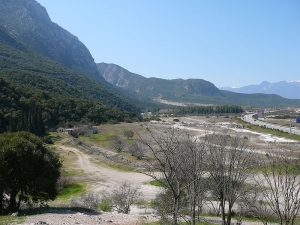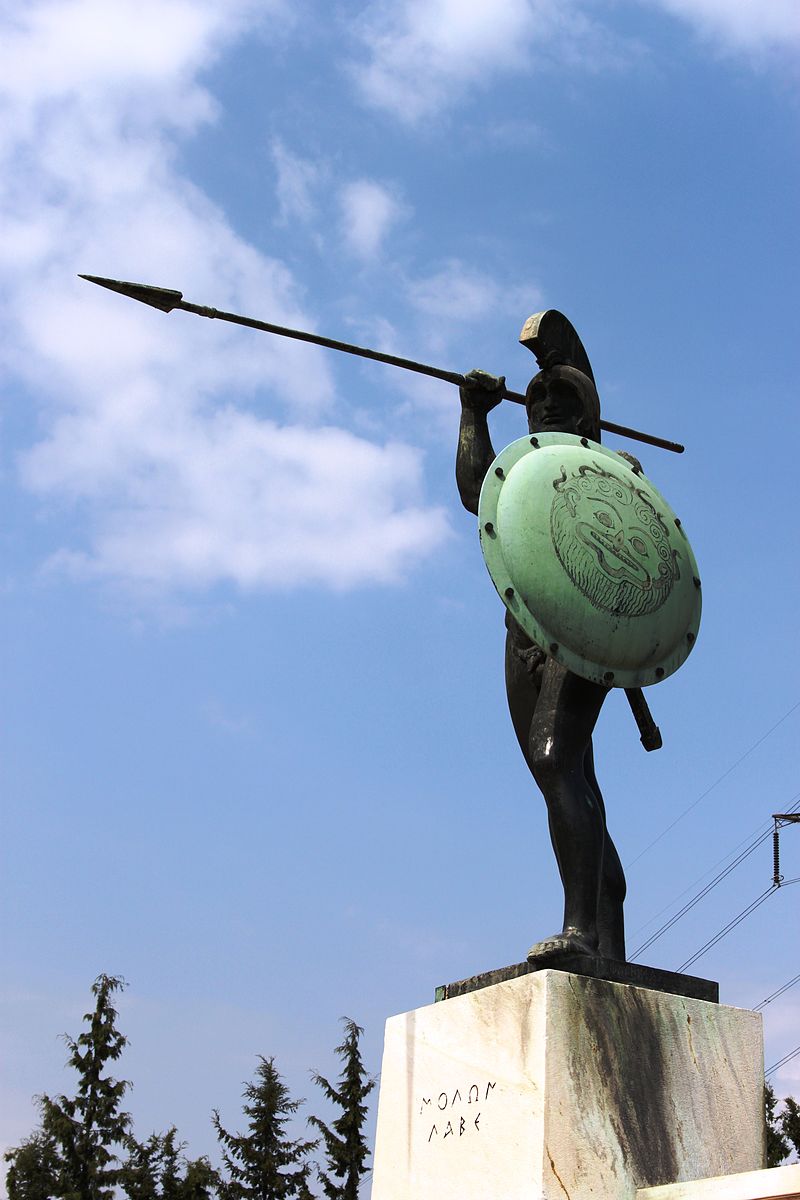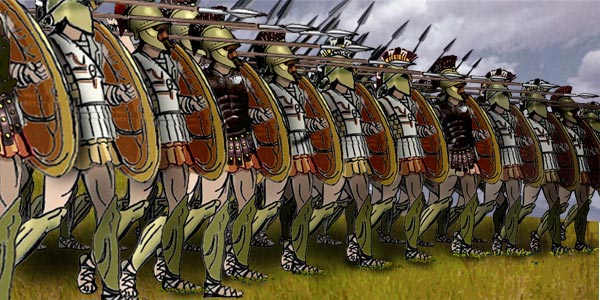The year was 480 BC and the Battle of Thermopylae was about to commence. King Leonidas I was dispatched from Sparta with only his royal bodyguard of 300 men to help him stop the oncoming Persian invasion, led by Xerxes I.
Fortunately Leonidas was not entirely alone. He was able to procure more soldiers: an additional number of support troops, including 1,000 Phocians, drawn from other parts of Lacedaemon. He was also able to reinforce his army en route, taking contingents from cities as he passed through. Eventually, he amassed around 7,000 men to block the pass at Thermopylae.
When he arrived, Leonidas camped out at the ‘middle gate’, the narrowest section of the pass. Unfortunately, news arrived from Trachis, the local town, that there was, in fact, a mountain track. It wasn’t large, but it could be used to outflank the Greeks, and therefore destroy their strategy. Leonidas quickly sent the Phocians troops to protect the spot.
Finally, in mid-August the Persian army was spotted. But how many men were the Peloponnesians and their allies up against?

Leonidas at Thermopylae, by Jacques Louis David, 1814. This is a juxtaposition of various historical and legendary elements from the Battle of Thermopylae.
The most fascinating aspect about the Battle of Thermopylae is the numbers, yet the actual figures are highly contended. The first writer to throw in his hat was Herodotus… and his calculations were some of the most amazing of them all.
The ‘Father of History’ described the scene as 6,100 Greeks, including 300 Spartans, 700 Thespians and 400 Thebans in comparison to an impressive 5.2 million Persians. Simonides, a near contemporary poet, estimated 4 million in Xerxes’ army. Modern scholars, however, say these figures were exaggerations, but still consider at least 70,000 to 300,000 in the invading forces.
Either way, the Greeks were clearly outnumbered.
At this time, Xerxes sent an emissary to negotiate with Leonidas. Their terms were that if the Greeks got out of their way, they would be offered their freedom and the title of “Friends of the Persian People”. In addition, they would be given land which was considered even better than what they already had.
Leonidas refused completely.
The ambassador then, more forcefully, demanded that the Greek troops lay down their arms.
Leonidas, once again refused. He only replied: “Come and take them”.
A messenger was then sent to Leonidas’ general, reporting the refusal and threatening, “Our arrows will block out the sun”.
Leonidas’ general retorted, “Then we shall have our battle in the shade!”
War was inevitable.
Xerxes waited four days for the opposing troops to disperse, and when they didn’t, they began to attack.
First Xerxes ordered 5,000 archers to fire a barrage of arrows at the Greeks, but their bronze helmets and shields deflected the attack. No real damage was done. Then Xerxes sent a force of 10,000 men which soon turned into a full frontal assault.
Meanwhile, Leonidas’ army stayed at the smallest section of the pass and spanned the opening with a standard Greek phalanx. They stood shoulder to shoulder to create a wall of overlapping shields, with their spear points dangerously protruding outwards. He rotated different units from each city to prevent battle fatigue. They also used a tactic where they would feign retreat, then turn and kill the soldiers as they tried to run after them.
The Persians, with their inferior weaponry, were not able to effectively engage the Greek soldiers. It was said that Xerxes jumped out of his seat three times as he watched his men get slaughtered. According to Ctesias, this first wave only resulted in two or three Spartans dead.
For his second assault on the same day, Xerxes sent in his elite forces, ‘the immortals’ to do what his previous men could not. Unfortunately for the Persians, ‘the immortals’ fared no better. The Spartans were just that good.
On the second day of battle, Xerxes sent his infantry, supposing that the much smaller Greek army would be weakened, tired and at least a little wounded from yesterday’s onslaught. However, once again Leonidas’ men triumphed, and Xerxes at last deceased the assault. He returned to camp, “completely perplexed”.
It was then that Xerxes received his first bit of good news.
While thinking of what to do next, a Trachinian traitor named Ephialtes (a name which became synonymous with the word ‘nightmare’), told Xerxes of the secret mountain pass. Moreover, he promised to lead the army there. Xerxes immediately sent the rest of his dear ‘immortals’ to check it out.
It was now the third day, at dawn, when the Persian forces surprised the Phocians who were meant to be guarding the mountain track. Unprepared, the Phocians began to retreat when Xerxes’ men bombarded them with arrows. They marched past the wounded Phocians with the goal of encircling the Greek army.
Leonidas’ mission was now doomed.
The Spartan king heard the unfortunate news from a runner and called for a council of war. Leonidas told them that he would not leave, but most of his contingents decided otherwise. All Leonidas had left was his own 300 royal bodyguards, 400 Thebans, as well as 700 Thespians. The Thespian general, Demophilus, refused to desert, but instead choose to fight to the death. This was all the more incredible, as the 700 men were all the hoplites the city could muster.
And so on the third day, the battle came to an end. Xerxes waited just long enough for his ‘immortals’ to descend the other side of the mountain, and then poured 10,000 men into the fight. The few remaining Greeks left their position at the wall in attempt to kill as many Persians as possible.
Many great men fell, including Leonidas who was brought down by archers. The two sides fought over his body, but eventually the Greeks were able to get possession. The dwindling army fought with their spears, until they were all shattered. Then they battled with their short swords. Eventually, according to Herodotus, “they defended themselves to the last, those who still had swords using them, and the others resisting with their hands and teeth”.

The site of the battle today:
the road to the right is built on reclaimed land
and approximates the 480 BC shoreline.
Finally, the very last defenders were surrounded, and died under a rain storm of arrows. In 1939, a large numbers of Persian bronze arrowheads were excavated on the spot.
Xerxes’ army won the battle of Thermopylae, with the estimated loss of 20,000 men. The Greek rearguard, however, suffered in total around 2,000 deaths over the course of the three day battle.
Many have asked, why the self-sacrifice? Why did those remaining Greek soldiers stay, and not depart with the others?
Of course no one can know for sure, but one favorable interpretation is that it was a clever tactic by Leonidas. If all the contingents had stayed, then everyone would have been killed. Likewise, if they all left, the Persians would have been able to follow after them and finish the Greek army. Only with a small group of valiant warriors could they protect the Greek retreaters, who would live to fight another day.
And so, the battle of Thermopylae was decided… but the war was yet to end.
You can read more of the Prelude to the Battle of Thermopylae Here: https://classicalwisdom.com/battle-of-thermopylae
“Thermopylae The Battle in the Shade” was written by Anya Leonard












2 comments
I suspect that Leonidas’s allies were Thebans, i.e, from the city of Thebes. Thespians are usually actors. There may have been some actors amongst them, but certainly not all 700 of them, even if they did stage a good fight.
Actually the Thespians were from Thespiae. Thespiae was a Greek city and a member of the Boeotian League along with Thebes and Plataea. 1,100 soldiers from Boeotian League, under the command of a Thespian (someone from Thespiae) commander decided to stay with the Spartans in an attempt to allow the other 3,000ish Greeks to retreat. Thereby spreading the word of what happened at Thermopylae, providing information about the Persian forces to the other Greek commanders, and giving the Greeks some time to prepare before the next large full scale battle.
Trackbacks
Our apologies, you must be logged in to post a comment.